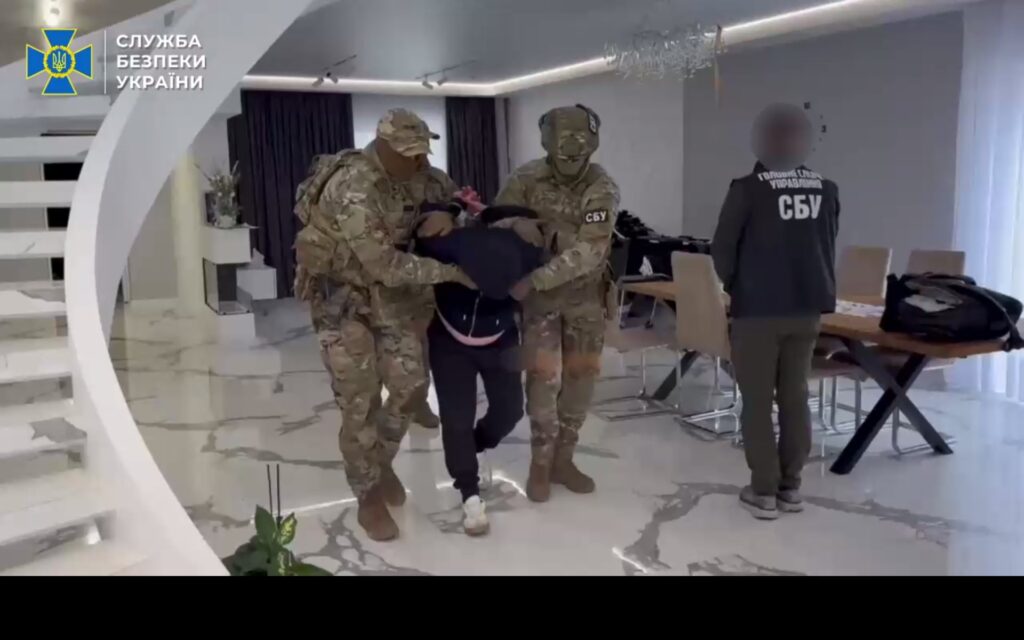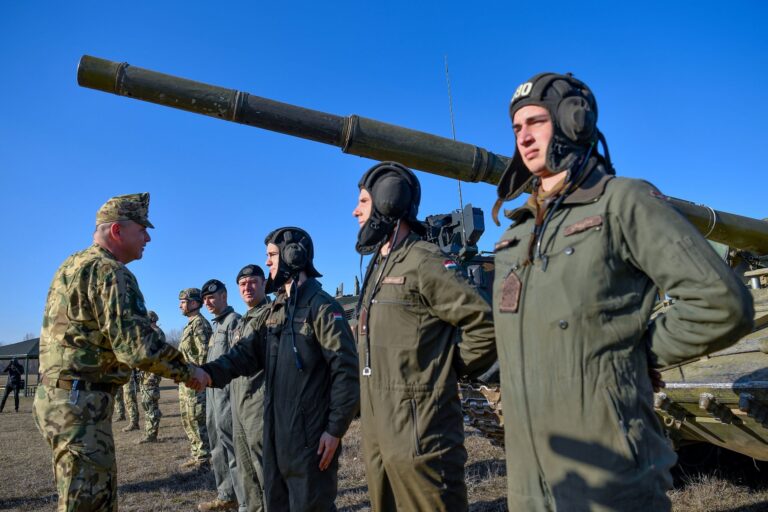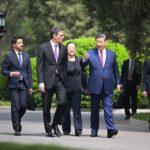Hungarian authorities have consistently promoted a narrative of neutrality in Russia’s war against Ukraine, insisting that Budapest seeks only to avoid being “drawn into a military conflict.” Yet mounting evidence suggests that Hungary has, at the very least, maintained contingency plans for a potential military incursion into Western Ukraine since as early as 2014—plans that appear to be continuously updated and may even be coordinated with the Kremlin.
Two key developments point to this strategic intent:
- The apparent preparation for an incursion in February 2022.
- Covert intelligence operations carried out by Hungarian military intelligence in Ukraine’s Zakarpattia region.

In the latter half of February 2022, mechanized units of the Hungarian Armed Forces—under the command of Lieutenant General Romulusz Ruszin-Szendi—were deployed near the Ukrainian border in the Szabolcs-Szatmár-Bereg region. The units were stationed at the Ádám Vay Training Base near Hajdúhadház and included T-72 tanks, infantry fighting vehicles, Hydran armored personnel carriers, and artillery systems.



While the official explanation cited preparations to secure Hungary’s border in the event of a mass influx of refugees due to the deteriorating situation in Ukraine, the deployment raises questions. Notably, it suggests that Budapest had prior knowledge of the Russian invasion’s scope and timeline. Moreover, the decision to mobilize heavy mechanized forces—rather than border guards or humanitarian units—seems disproportionate and strategically incongruent with the stated objective of managing refugee flows. Instead, it may reveal deeper, concealed intentions regarding Hungary’s posture toward its eastern neighbor.
Hungarian authorities have maintained a public stance of strict neutrality in Russia’s war against Ukraine. Official statements emphasize that Hungary will not be drawn into the conflict and will continue to avoid any form of military engagement. However, credible indications suggest that this narrative may mask a far more complex reality.
We assess that since at least 2014, the Hungarian government has maintained and continually revised military contingency plans for an incursion into Western Ukraine—plans that may be informally coordinated with Moscow.
Two developments support this assessment:
- Hungary’s preparation for a potential incursion in February 2022.
- The active presence of Hungarian military intelligence networks in Ukraine’s Zakarpattia region.
In the third week of February 2022, mechanized units of the Hungarian Armed Forces, under the command of Lieutenant General Romulusz Ruszin-Szendi, were deployed near the Ukrainian border in Szabolcs-Szatmár-Bereg County. Troops were stationed at the Ádám Vay Training Base near the town of Hajdúhadház. The formation was reinforced with T-72 tanks, infantry fighting vehicles, Hydran armored personnel carriers, and artillery systems.
The official explanation claimed this deployment was a precautionary measure aimed at managing a possible influx of refugees fleeing the expected Russian invasion. However, the nature of the forces involved raises critical questions. The deployment of heavy mechanized units—rather than humanitarian or border patrol resources—appears disproportionate to the stated goal and strongly suggests that Budapest had prior knowledge of the invasion’s timing and likely operational depth.
More importantly, the scale and composition of the Hungarian deployment reveal strategic intentions that go far beyond crowd control. The use of such military hardware points to a readiness for cross-border operations, rather than a purely defensive posture. In this context, Hungary’s narrative of neutrality becomes increasingly difficult to reconcile with its military behavior on the ground.
Disproportionate Force Size and Armament
- The scale of Hungarian military forces deployed—complete with armored vehicles, mechanized infantry, and advanced surveillance systems—far exceeded typical requirements for border patrol or refugee processing, which usually involve police or border guards.
- No refugee influx at the time justified the presence of combat-ready units, especially given that Ukraine had not yet seen full-scale refugee outflows before Russia’s invasion on February 24, 2022.
2. Offensive Positioning, Not Defensive
- Units were reportedly positioned in military formations and staging zones, suggesting tactical readiness for cross-border operations rather than humanitarian aid or crowd control.
- Troops were located closer to the Zakarpattia region, where ethnic Hungarians live—indicating potential planning for intervention under the pretext of “protecting minorities.”
3. Timing and Coordination
- The deployment coincided with increased Russian military activities near Ukraine and intensified Kremlin rhetoric about protecting Russian speakers abroad. Hungary’s sudden military presence near Ukraine aligned suspiciously with broader destabilization efforts.
- No coordination with NATO or EU mechanisms for migration management was publicly disclosed, raising suspicions of independent military maneuvering.
4. Historical Irredentist Narratives
- Hungary’s far-right and some elements within the Fidesz party have voiced interest in revisiting the Treaty of Trianon, fueling concerns that military forces could be used to assert historical claims over Zakarpattia.
- Military presence in this context appears more geopolitical than humanitarian.
5. Lack of Civil Infrastructure for Refugee Management
- No significant deployment of civilian refugee support infrastructure (housing, logistics, health services) was observed alongside troops. This strongly indicates the forces weren’t there for refugee protection but rather for potential territorial or intelligence objectives.
Hungarian forces were reinforced with logistical support units during their February 2022 deployment, a detail that strongly suggests preparation for operations in territories far beyond the immediate border zone—namely, areas without access to Hungary’s domestic logistical infrastructure. This points to a broader strategic objective: a potential armed incursion into Ukraine’s Zakarpattia region in the event of a collapse of central authority in Kyiv.
We assess with high confidence that Budapest contemplated such a scenario under the pretext of protecting the ethnic Hungarian minority in western Ukraine—especially if advancing Russian forces reached the Carpathian region. A planned incursion, disguised as a peacekeeping mission, would have served to minimize backlash from both the European Union and NATO. Supporting this theory is a sustained campaign of intelligence gathering by Hungary’s military intelligence agency, which has been actively building an espionage network inside Zakarpattia.
The motivation and contours of this possible intervention appear consistent and ongoing, hinging on either a genuine or manufactured crisis involving the rights of ethnic Hungarians in Ukraine. Hungarian intelligence, however, likely faces a serious obstacle similar to that which hindered Russian planners in 2022: a failure to accurately assess the mood and loyalties of the local population. This challenge is exacerbated by widespread embezzlement of Budapest’s financial aid programs intended for Hungarian communities in western Ukraine, which further distorts the picture on the ground.
Hungary’s renewed interest in Zakarpattia’s military infrastructure strongly indicates that its military plans have been recently updated. The February 2022 troop deployment—timed just before Russia’s full-scale invasion—was not an isolated act of border protection, but rather a preparatory move linked to a broader wartime contingency plan. Public statements from Hungary’s foreign ministry, declaring non-involvement in the war, should therefore be viewed as disinformation and strategic distraction.
This leads to a sobering conclusion: Hungary’s reluctance to support NATO and EU efforts to arm Ukraine may stem less from neutrality and more from a desire to avoid bolstering Ukrainian defenses in regions Budapest views as potential targets for future intervention.
At the same time, we cannot dismiss the possibility of intelligence leaks from NATO to Russia, including details on weapons deliveries and deployment plans. We have strong reasons to believe that official Budapest is operating in close coordination with both Russian military intelligence (GRU) and the Foreign Intelligence Service (SVR).





